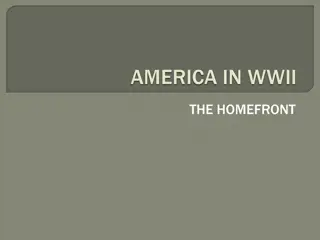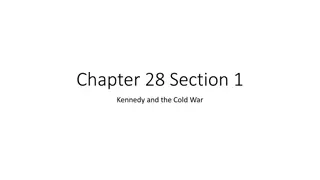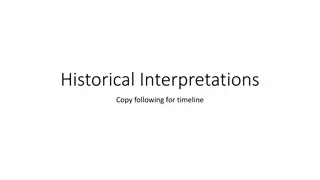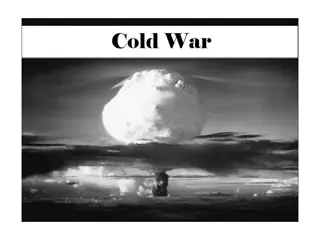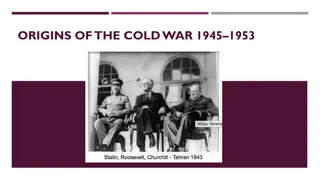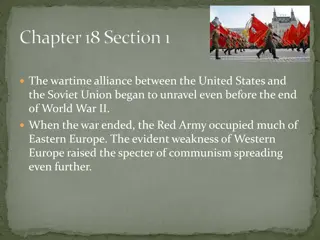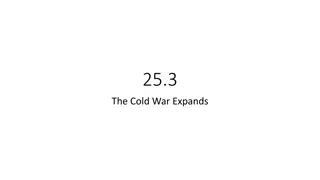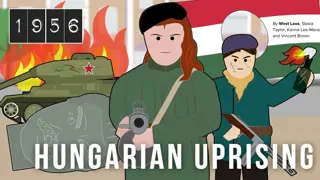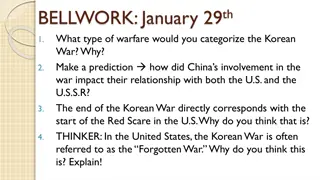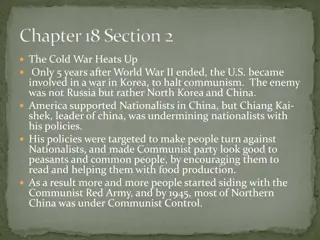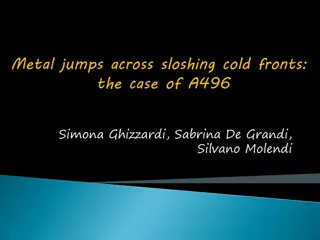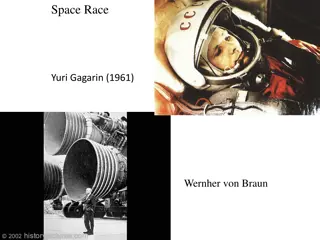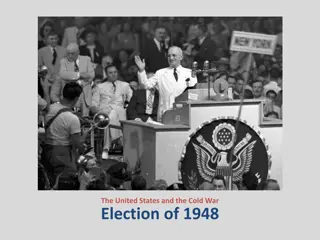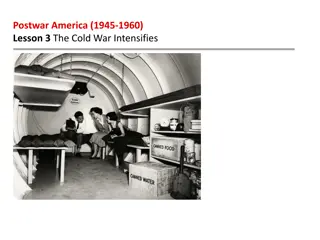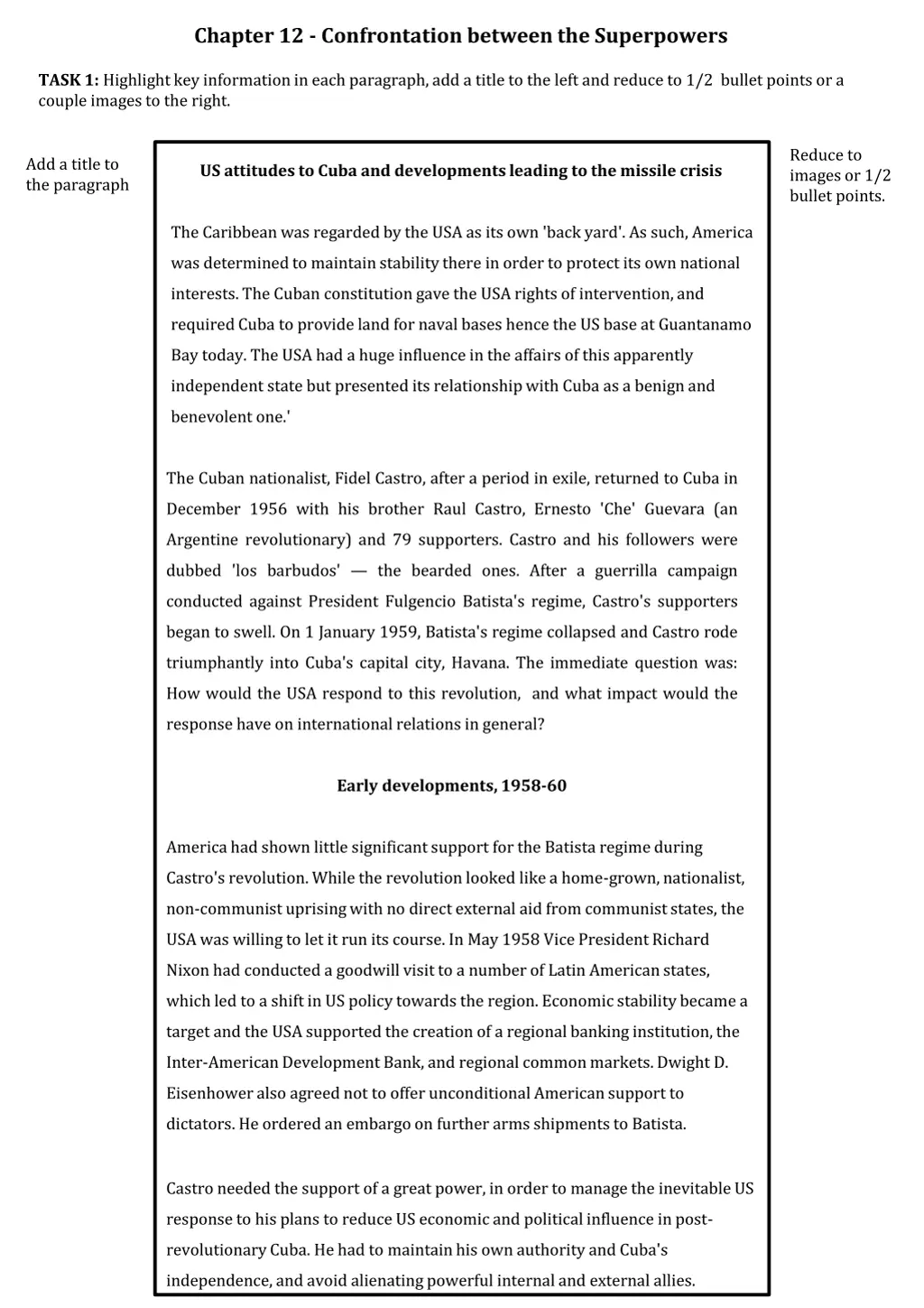
Confrontation Between Superpowers: US-Cuba Relations and the Missile Crisis
Explore the evolving relationship between the USA and Cuba, from initial support to economic sanctions, leading to the Cuban Missile Crisis. Discover how Fidel Castro's rise to power and alignment with the Soviet Union triggered a significant geopolitical shift in the Cold War era.
Download Presentation

Please find below an Image/Link to download the presentation.
The content on the website is provided AS IS for your information and personal use only. It may not be sold, licensed, or shared on other websites without obtaining consent from the author. If you encounter any issues during the download, it is possible that the publisher has removed the file from their server.
You are allowed to download the files provided on this website for personal or commercial use, subject to the condition that they are used lawfully. All files are the property of their respective owners.
The content on the website is provided AS IS for your information and personal use only. It may not be sold, licensed, or shared on other websites without obtaining consent from the author.
E N D
Presentation Transcript
Chapter 12 - Confrontation between the Superpowers TASK 1: Highlight key information in each paragraph, add a title to the left and reduce to 1/2 bullet points or a couple images to the right. Reduce to images or 1/2 bullet points. Add a title to the paragraph US attitudes to Cuba and developments leading to the missile crisis The Caribbean was regarded by the USA as its own 'back yard'. As such, America was determined to maintain stability there in order to protect its own national interests. The Cuban constitution gave the USA rights of intervention, and required Cuba to provide land for naval bases hence the US base at Guantanamo Bay today. The USA had a huge influence in the affairs of this apparently independent state but presented its relationship with Cuba as a benign and benevolent one.' The Cuban nationalist, Fidel Castro, after a period in exile, returned to Cuba in December 1956 with his brother Raul Castro, Ernesto 'Che' Guevara (an Argentine revolutionary) and 79 supporters. Castro and his followers were dubbed 'los barbudos' the bearded ones. After a guerrilla campaign conducted against President Fulgencio Batista's regime, Castro's supporters began to swell. On 1 January 1959, Batista's regime collapsed and Castro rode triumphantly into Cuba's capital city, Havana. The immediate question was: How would the USA respond to this revolution, and what impact would the response have on internationalrelations in general? Early developments, 1958-60 America had shown little significant support for the Batista regime during Castro's revolution. While the revolution looked like a home-grown, nationalist, non-communist uprising with no direct external aid from communist states, the USA was willing to let it run its course. In May 1958 Vice President Richard Nixon had conducted a goodwill visit to a number of Latin American states, which led to a shift in US policy towards the region. Economic stability became a target and the USA supported the creation of a regional banking institution, the Inter-American Development Bank, and regional common markets. Dwight D. Eisenhower also agreed not to offer unconditional American support to dictators. He ordered an embargo on further arms shipments to Batista. Castro needed the support of a great power, in order to manage the inevitable US response to his plans to reduce US economic and political influence in post- revolutionary Cuba. He had to maintain his own authority and Cuba's independence, and avoid alienating powerful internal and external allies.
Reduce to images or 1/2 bullet points. Add a title to the paragraph In May 1959, Castro introduced a programme of agrarian reform, which led to considerable amounts of American-owned property being seized by the state. These early reforms were moderate rather than revolutionary, and they did not instantly generate a hostile US response. US fears of Cuba becoming a Soviet satellite in the Caribbean, and a base from where pro-communist regimes could be managed across Latin America, were heightened when Soviet First Deputy Premier Anastas Mikoyan visited Cuba in February 1960 and arranged $100 million dollars in credits with Castro. This inevitably tied Cuba into not only an economic relationship with the Soviet Union, but also a political one. The first shipment of crude oil from the USSR arrived in Cuba in April 1960, and when US-owned oil companies refused to refine it, Castro nationalised them. America immediately imposed economic sanctions on Cuba and reduced their imports of Cuban sugar by 95 per cent. This downward spiral in US-Cuban relations continued when Castro seized $1 billion worth of US assets on Cuba in October 1960. Castro needed the Soviet Union for both foreign and domestic reasons. By 1961, the USA decided that the time had come to remove Castro and his regime from Cuba. TASK 2: How do these images represent what you have just read?
Brinkmanship (test the USA s strength to see if they would back off or enter direct conflict) Increase Close the missile gap between the USA and USSR bargaining power with the USA Why did Khrushchev put missiles on Cuba?: Possible explanations Trap the USA into nuclear war Defend Cuba TASK 3: Below is evidence which can be used to support one or more of the explanations above. Write in the letter of the statement in the correct place on the mindmap: A. B. Protecting Cuba gave Khrushchev a reason to produce more nuclear missiles and warheads Having missiles on Cuba would mean the USSR was closer to matching the number the USA had in place in Western Europe and Turkey. The USSR had more medium and short range missiles (they were much cheaper than long range missiles). A launch site in Cuba was ideal as it was so close to the coastline of the USA. By defending Castro, Khrushchev could ensure that the only Communist country in the USA s sphere of influence remained Communist. Cuba had been attacked once already by the USA. Although the Bay of Pigs attack was a fiasco for the USA, it could be seen as a sign that the US would attack again. Khrushchev needed to strengthen his own political position within the USSR. Putting missiles on Cuba could show he was strong and standing up to the USA. C. D. E. F. TASK 4: Draw arrows on the mind map to show links between Khrushchev s reasons for putting nuclear weapons on Cuba Explain these links Number the reasons from 1-5 according to which explanations you think is the most likely to be correct looking at the evidence (1 = most likely) Explain your decisions in a paragraph on the next page 1. 2. 3.
______________________________________________________________________________________________________________________________ _______________________________________________________________ _______________________________________________________________ _______________________________________________________________ _______________________________________________________________ _______________________________________________________________ _______________________________________________________________ _______________________________________________________________ _______________________________________________________________ _______________________________________________________________ _______________________________________________________________
TASK 5: Cornell Notes from textbook/powerpoint Bay of Pigs/Operation Mongoose/Soviet deploy nuclear missiles p.95-96 Keywords/Questions Summery
TASK 5: Cornell Notes from textbook/powerpoint 13 days of the crisis/End in sight/ significance p.97-101 Keywords/Questions Summery
TASK 6: Who won the Cuban Missile Crisis. Choose two colours and symbols and highlight the consequences showing whether they show the USA won or the USSR. Cuba was still a poor country after the crisis. It was the only communist country in their area of the world. This was mainly because the USA would not buy their goods or sell them goods they needed. It meant Cuba had to rely on the USSR (Russia) instead which was far away. Kennedy was seen as a better leader by the American people and others around the world at the end of the crisis. He had stood up to the Soviets (USSR / Russia) and they had backed down Castro stayed in power in Cuba and the USA promised them they would not invade Cuba again. The USSR had lied to the UN and to the world about putting the nuclear missiles on Cuba Kennedy had stood up to his military advisers (people who were in charge of the army, navy and air force). The advisors wanted to invade Cuba and Kennedy disagreed. Kennedy showed them that their ideas were dangerous. Castro was still leader after the crisis. It was a problem for the USA that there was a communist country which was supported by the USSR (Russia) so close to them Khrushchev could claim to the world that he had acted reasonably and as a peacemaker because he had agreed to remove the missiles from Cuba (remember his letters to Kennedy were not known about by the public at the time). D Khrushchev had been forced to back down by the USA. Soviet (Russian) missiles were removed from Cuba and people in the USSR (Russia) felt humiliated. Castro kept control of the business on Cuba which had once belonged to the USA. Khrushchev had stopped the USA from invading Cuba and the USA promised not to do it again. Khrushchev could not tell the world that the USA promised to remove missiles from Turkey (these agreements were secret at the time). This meant that the rest of the world did not see that Khrushchev was successful in getting Kennedy to do something he wanted. Khrushchev had an agreement from the USA that NATO missiles would be removed from Turkey. Kennedy had been forced to give Khrushchev something he wanted. Kennedy agreed in secret not to invade Cuba again and remove missiles from Turkey Cuba still had lots of weapons (although not with nuclear weapons). Other communist countries in central America looked up to them. Kennedy had made plenty of enemies. His military advisers (people who were in charge of the army, navy and air force) did not trust him and thought he was weak. The Cubans who had fought and lost at the Bay of Pigs invasion hated him because Castro was still in power in Cuba. In 1964, Khrushchev was sacked. Historians argue that this was because of the events in Cuba. After the crisis, there were less American people who wanted the government to stand up to the USSR. This meant there was less pressure to attack a communist country again. Cuba still relied on the USSR (Russia) and it was useful for them to have a friendly communist country so close to their enemy, the USA. TASK 7 - Ultimately, who won and why? Key ______________________________________________________________________________________________ USA ______________________________________________________________________________________________ USSR ______________________________________________________________________________________________ ______________________________________________________________________________________________
The Cuban Missile Crisis was a triumph for the Soviet Union. Assess the validity of this view. PARAGRAPH 1 Introduction of paragraph 1 agreeing List the historical knowledge that supports the statement. How does this historical knowledge answer the question Mini judgement on validity
The Cuban Missile Crisis was a triumph for the Soviet Union. Assess the validity of this view. PARAGRAPH 2 Introduction of paragraph 1 disagreeing List the historical knowledge that supports the statement. How does this historical knowledge answer the question Mini judgement on validity
NOTES _____________________________________________________________________ _____________________________________________________________________ _____________________________________________________________________ _____________________________________________________________________ _____________________________________________________________________ _____________________________________________________________________ _____________________________________________________________________ _____________________________________________________________________ _____________________________________________________________________ _____________________________________________________________________ _____________________________________________________________________ _____________________________________________________________________ _____________________________________________________________________ _____________________________________________________________________ _____________________________________________________________________ _____________________________________________________________________ _____________________________________________________________________ _____________________________________________________________________ _____________________________________________________________________ _____________________________________________________________________ _____________________________________________________________________ _____________________________________________________________________ _____________________________________________________________________ _____________________________________________________________________ _____________________________________________________________________ _____________________________________________________________________ _____________________________________________________________________ _____________________________________________________________________ _____________________________________________________________________ _____________________________________________________________________ _____________________________________________________________________
NOTES _____________________________________________________________________ _____________________________________________________________________ _____________________________________________________________________ _____________________________________________________________________ _____________________________________________________________________ _____________________________________________________________________ _____________________________________________________________________ _____________________________________________________________________ _____________________________________________________________________ _____________________________________________________________________ _____________________________________________________________________ _____________________________________________________________________ _____________________________________________________________________ _____________________________________________________________________ _____________________________________________________________________ _____________________________________________________________________ _____________________________________________________________________ _____________________________________________________________________ _____________________________________________________________________ _____________________________________________________________________ _____________________________________________________________________ _____________________________________________________________________ _____________________________________________________________________ _____________________________________________________________________ _____________________________________________________________________ _____________________________________________________________________ _____________________________________________________________________ _____________________________________________________________________ _____________________________________________________________________ _____________________________________________________________________ _____________________________________________________________________

